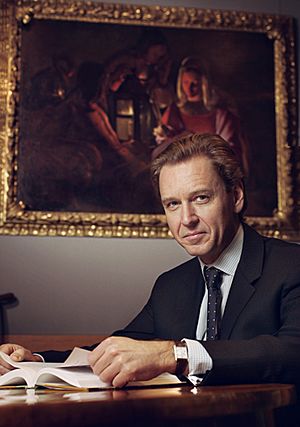Timothy Potts facts for kids
Quick facts for kids
Timothy Potts
|
|
|---|---|
 |
|
| Director of the J. Paul Getty Museum | |
| Assumed office 1 September 2012 |
|
| Preceded by | James Cuno (acting) |
| Director of the Fitzwilliam Museum | |
| In office 2007–2012 |
|
| Preceded by | Duncan Robinson |
| Succeeded by | Tim Knox |
| Director of the Kimbell Art Museum | |
| In office 1998–2007 |
|
| Preceded by | Edmund P. Pillsbury |
| Succeeded by | Eric McCauley Lee |
| Director of the National Gallery of Victoria | |
| In office 1994–1998 |
|
| Preceded by | James Mollison |
| Succeeded by | Gerard Vaughan |
| Personal details | |
| Born | 1958 (age 66–67) Sydney, Australia |
| Education | University of Sydney (BA) Christ Church, Oxford (DPhil) |
| Occupation | Art historian, archaeologist, museum director |
Timothy Potts is an Australian expert who studies art history and ancient cultures. He is also a museum director, which means he leads museums. Since September 1, 2012, he has been the director of the famous J. Paul Getty Museum.
Contents
About Timothy Potts
Timothy Potts was born in Sydney, Australia, in 1958. He went to the University of Sydney for his first degree. Later, he studied at the University of Oxford in England. There, he earned a special degree called a DPhil. His studies focused on the art and ancient history of the Near East. This area includes countries like Jordan and Iraq today.
Early Career and Discoveries
From 1985 to 1990, Timothy Potts worked as a researcher at Christ Church, Oxford. He taught about ancient Near Eastern art and archaeology. He also helped lead archaeological digs in Pella, Jordan, from 1982 to 1989. This means he helped uncover ancient ruins and artifacts.
For a few years, from 1990 to 1994, he worked in finance in New York and London. After that, he returned to his passion for museums.
Leading Major Museums
Timothy Potts has led several important art museums around the world:
- He was the director of the National Gallery of Victoria in Australia from 1994 to 1998.
- From 1998 to 2007, he directed the Kimbell Art Museum in Fort Worth, Texas, USA.
- He then became the director of the Fitzwilliam Museum in Cambridge, England, from 2007 to 2012.
- Since 2012, he has been the director of the J. Paul Getty Museum in Los Angeles, California.
As a museum director, he helps decide what art the museum buys. He also plans exciting exhibitions for visitors.
His Writings
Timothy Potts is an expert in the art and archaeology of ancient cultures. He has written many books and articles on these topics. His writings help people learn about the history of art and ancient civilizations.
Some of his works include:
- Kimbell Art Museum: Handbook of the Collection
- From Renoir to Picasso : Masterpieces from the Musee de L'Orangerie
- Mesopotamia & the East: An Archaeological & Historical Study of Foreign Relations 3400-2000 Bc.
Achievements at the Kimbell Art Museum
During his time at the Kimbell Art Museum, Timothy Potts helped the museum grow. He added many amazing artworks to its permanent collection. These new pieces included sculptures, paintings, and ancient artifacts.
Notable Art Acquisitions
Some of the artworks acquired under his leadership include:
- Sculptures like St John the Baptist by Michelozzo and Virgin and Child by Donatello.
- Paintings such as The Judgment of Paris by Lucas Cranach the Elder.
- Ancient pieces like Head of an Athlete from ancient Greece.
- Art from the Maya culture, like a 5th-century Jade Belt Ornament.
- Asian art, including Bamboo and Rocks by Tan Zhirui.
Special Exhibitions
The Kimbell Art Museum also hosted many interesting exhibitions while he was director. These shows brought unique art from around the world for people to see.
Some of these exhibitions were:
- Picturing the Bible: The Earliest Christian Art
- Drama and Desire Japanese Paintings from the Floating World
- Hatshepsut: From Queen to Pharaoh
- Gauguin and Impressionism
- Turner and Venice
- Caravaggio to Dalí: 100 Masterpieces from the Wadsworth Atheneum Museum of Art
- The Quest for Immortality: Treasures of Ancient Egypt
- Matisse & Picasso: A Gentle Rivalry

